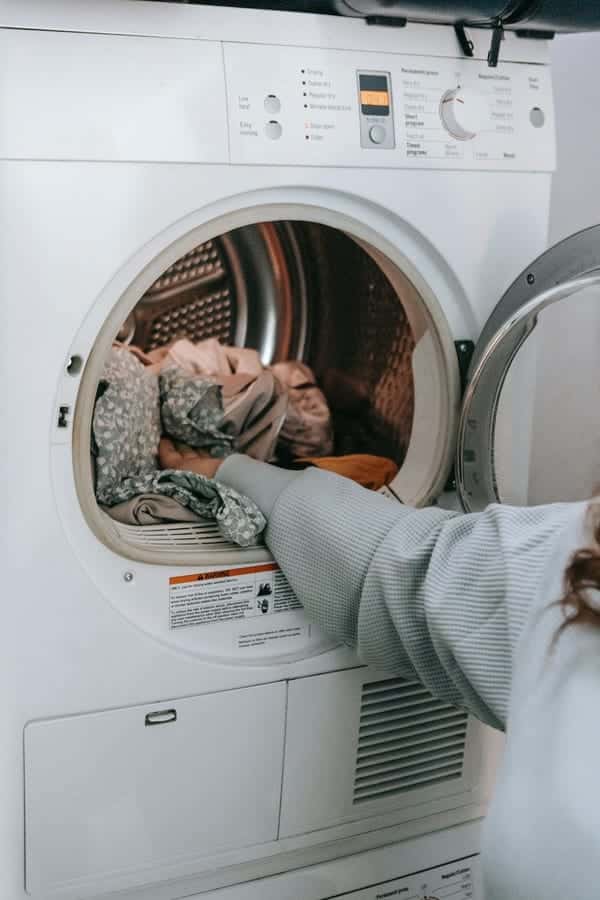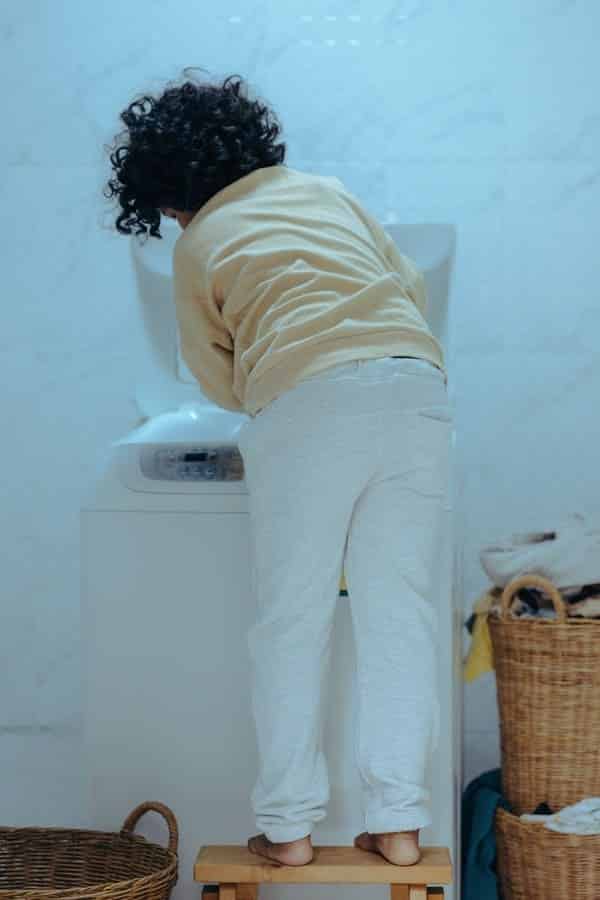One of the things that might get missed in your monthly deep clean is your comforter. They’re big, fluffy, and cozy, but the things lurking inside them can be much more sinister.
All of your lovely dead skin cells, saliva, and sweat get absorbed by your innocent-looking bedding and create a little germ-fest. Yummy.
Although bedding will protect your comforter, it’s a good idea to give your duvet a deep clean every few months. You don’t need to wash the comforter as often as your bedding, but doing it a few times a year will keep your bedding smelling fresh.
You might not notice how dirty your comforter is when you change the bedding but take a quick look. You’ll be guaranteed to find the odd moisture mark or grease stain that needs tackling.
So what do you need to do to fix it? It can be an intimidating task to wash such a big, expensive item.
And you don’t want to screw it up and ruin the nice fluffiness. Depending on the level of dirt you’re trying to tackle, there are two super simple methods to try out to remove any kind of stain or discoloration on your duvet.
- Removing Stains from White Comforter by Spot Cleaning.
- Step 1. Read the care label.
- Step 2. Move the filling away from the stain.
- Step 3. Assemble the cleaning agent.
- Step 4. Apply and blot.
- Step 5. Rub the stain and rinse.
- Step 6. Dry the comforter.
- Removing Stains on Your White Comforter using a Washing Machine.
- Step 1. Inspect and Repair.
- Step 2. Select the washing machine setting.
- Step 3. Tumble dry.
- Step 4. Hang to dry.
- How to Make Yellow Comforters White Again.
- How to Remove Wine or Blood Stains from White Comforter.
- To Summarize.
There may be affiliate links in this article. You can read more about this in my disclosure.
Removing Stains from White Comforter by Spot Cleaning.

If you’ve noticed a grease smear or a food spill, you might be able to do a little spot cleaning to make your comforter look as good as new. This is definitely easier than trying to wash the entire duvet, so you’re in luck.
Here are some steps to follow to spot-clean the stains on white comforters.
Step 1. Read the care label.
The care instructions may vary depending on the material of your comforter, so it’s best to always to check the manufacturer’s recommendations first.
Some comforters may require dry clean only, and most will have temperature speciations for washing.
Step 2. Move the filling away from the stain.
Locate the stain, and move the internal filling of the blanket to prevent it from being damaged or soaked unnecessarily. It will just add drying time anyway.
Step 3. Assemble the cleaning agent.
If you have a store-bought cleaning agent suitable for the job, you can skip this step. Otherwise, in a bowl, mix together baking soda and water until a paste is formed.
Alternatively, mix together equal parts white vinegar and water. Do not use bleach.
It’s simply too harsh for the delicate fibers.
Step 4. Apply and blot.
Apply a small amount of your chosen cleaning agent to the stain. Then, press the area with a white cloth, blotting it repeatedly.
Step 5. Rub the stain and rinse.
If the stain is a little more stubborn, you may need to agitate it by rubbing the material against itself. Afterward, rinse the area with a small amount of water, squeezing out the excess and blotting with a dry cloth.
Step 6. Dry the comforter.
Either hang the comforter outside on a washing line to dry, or use a blow dryer to remove the majority of the moisture and let air dry to finish.
Air drying outside will make your duvet smell its freshest, so if possible, give the duvet some fresh air. The sun will also kill off any lingering bacteria, bonus!
Removing Stains on Your White Comforter using a Washing Machine.

If your washing machine is large enough, using it to wash your duvet is pretty easy. Make sure to check the comforter care label before doing so, it may give you instructions for temperature preference and detergent type.
Follow these simple steps to remove stains from your white comforter using a washing machine:
Step 1. Inspect and Repair.
Washing machines can be pretty intensive and can exacerbate any faults and imperfections your duvet may already have. Inspect the stitching on your comforter, and locate any tears or loose threads.
Hopefully, the faults are minor enough that you can quickly repair them using a needle and thread. This step will save you time in the long run, preventing any small issues from becoming huge problems.
Step 2. Select the washing machine setting.

Load the comforter into the machine, and add a little detergent to the dispenser. If possible, select the bulky setting on the washer and choose the appropriate temperature that is recommended on the label of your duvet.
After the first cycle, program another rinse cycle to make sure the comforter is properly rinsed clean of the detergent.
Hopefully, your machine is big enough to accommodate the duvet, and if it feels like too tight of a fit, it might be a better idea to head to a laundromat. Otherwise, you may block and flood your machine, which is not a pleasant clean-up process.
Step 3. Tumble dry.
Place the comforter into the dryer, and select a low-temperature setting. If you have any dryer balls, chuck them in to help fluff up the duvet.
Otherwise, some tennis balls will do the trick. Check the duvet every 30 minutes or so, taking it out and fluffing it up to prevent clumping.
Step 4. Hang to dry.
Once the duvet is mostly dry, hang it out to air dry. If you don’t have space for this, just finish the process in the dryer.
But this step does help fluff up and air out the duvet to help encourage it to return to its natural shape and fluffiness.

How to Make Yellow Comforters White Again.
Yellow stains are the enemy of any white garment. T-shirts, bedding, you name it, yellow ruins it.
It’s normal for comforters to yellow over time, but that doesn’t mean you shouldn’t try to get them back to box-fresh condition.
If the entire duvet has yellowed, fill a large bucket or a bath with warm water and a good amount of white vinegar. Balsamic really won’t help you here, white vinegar is a must.
Soak the comforter for 30 – 60 minutes. Then, rinse the duvet with cold water.
If the yellow still persists, repeat the process and consider adding even more vinegar. Once the duvet looks white and bright, put the duvet in the washing machine for a normal cycle, following the garment instruction label.
Then tumble dry on low heat with dryer balls or tennis balls.
No products found.
How to Remove Wine or Blood Stains from White Comforter.
If you’ve spilled some red wine or had an accident during that time of the month, you may be shocked to see bright red marks on your bedding.
But don’t panic, we have all been there, and these stains should disappear, they may just take a little more effort and tenacity.
Follow these steps to remove red stains from white comforters:
- If the stain occurred recently, absorb as much excess liquid as possible with some paper towels. Blot, don’t wipe, as you may spread the liquid.
- Pour a generous amount of salt (table salt will do, don’t waste your pink Himalayan rock salt on this step). Leave the salt for a few minutes to absorb the fluid, then brush away.
- If you have any pre-treating stain remover, apply some of this now, and let sit. If not, blot the stain with a cloth soaked in white vinegar.
- Wash the duvet in the washing machine according to manufacturer instructions. If your home machine isn’t large enough, take it to a laundromat.
- If the stains persist, repeat steps 2-4 again.
- Tumble dry on low heat with some dryer balls or tennis balls.

To Summarize.
Let’s be honest, nobody can ever really be bothered washing their comforter. Especially in the chilly months when you’re scared the process will take too long, and you will be stuck with a soggy duvet when it comes to bedtime.
But with the right know-how, it can be a relatively pain-free process. Try to wash the duvet at the beginning of every season, around every 3-4 months.
Use salt to draw out stains, or vinegar to remove old ones. If you’ve got the odd stain, attack it as soon as it happens as it’ll be much easier to remove.
If the first method you try doesn’t work, don’t worry. There are plenty of tips, tricks, and tweaks you can try that will work for you.
Last update on 2024-04-26 / Affiliate links / Images from Amazon Product Advertising API




